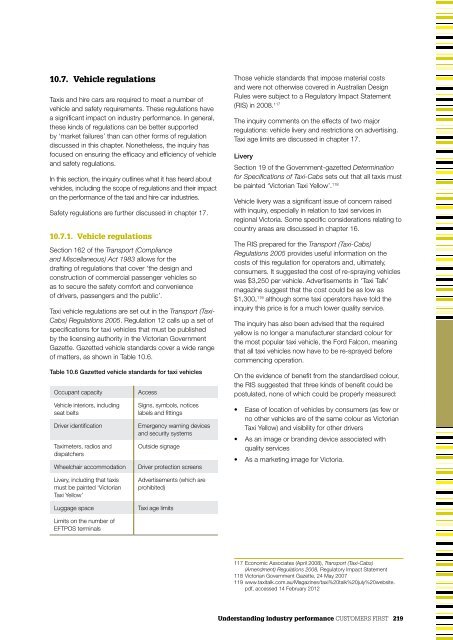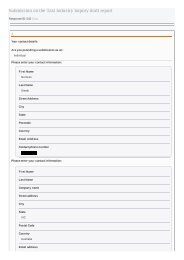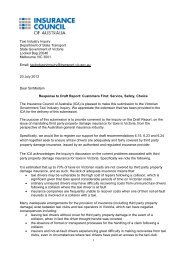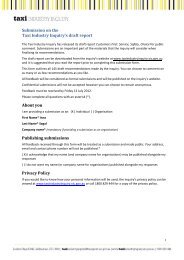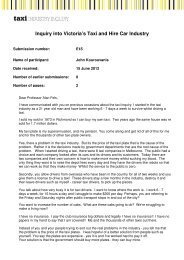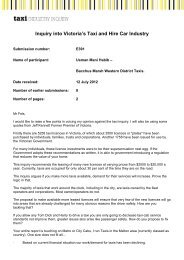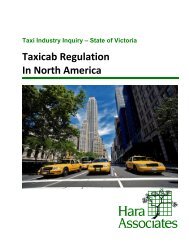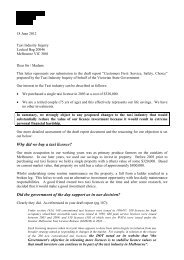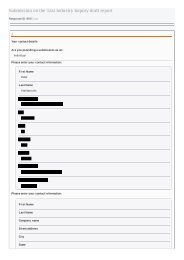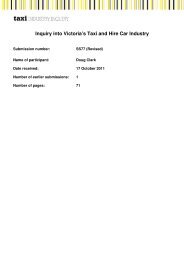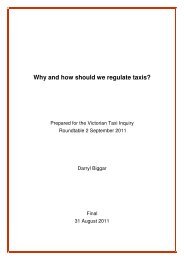Part D â Understanding and improving industry performance (PDF ...
Part D â Understanding and improving industry performance (PDF ...
Part D â Understanding and improving industry performance (PDF ...
You also want an ePaper? Increase the reach of your titles
YUMPU automatically turns print PDFs into web optimized ePapers that Google loves.
10.7. Vehicle regulations<br />
Taxis <strong>and</strong> hire cars are required to meet a number of<br />
vehicle <strong>and</strong> safety requirements. These regulations have<br />
a significant impact on <strong>industry</strong> <strong>performance</strong>. In general,<br />
these kinds of regulations can be better supported<br />
by ‘market failures’ than can other forms of regulation<br />
discussed in this chapter. Nonetheless, the inquiry has<br />
focused on ensuring the efficacy <strong>and</strong> efficiency of vehicle<br />
<strong>and</strong> safety regulations.<br />
In this section, the inquiry outlines what it has heard about<br />
vehicles, including the scope of regulations <strong>and</strong> their impact<br />
on the <strong>performance</strong> of the taxi <strong>and</strong> hire car industries.<br />
Safety regulations are further discussed in chapter 17.<br />
10.7.1. Vehicle regulations<br />
Section 162 of the Transport (Compliance<br />
<strong>and</strong> Miscellaneous) Act 1983 allows for the<br />
drafting of regulations that cover ‘the design <strong>and</strong><br />
construction of commercial passenger vehicles so<br />
as to secure the safety comfort <strong>and</strong> convenience<br />
of drivers, passengers <strong>and</strong> the public’.<br />
Taxi vehicle regulations are set out in the Transport (Taxi-<br />
Cabs) Regulations 2005. Regulation 12 calls up a set of<br />
specifications for taxi vehicles that must be published<br />
by the licensing authority in the Victorian Government<br />
Gazette. Gazetted vehicle st<strong>and</strong>ards cover a wide range<br />
of matters, as shown in Table 10.6.<br />
Table 10.6 Gazetted vehicle st<strong>and</strong>ards for taxi vehicles<br />
Occupant capacity<br />
Vehicle interiors, including<br />
seat belts<br />
Driver identification<br />
Taximeters, radios <strong>and</strong><br />
dispatchers<br />
Wheelchair accommodation<br />
Access<br />
Signs, symbols, notices<br />
labels <strong>and</strong> fittings<br />
Emergency warning devices<br />
<strong>and</strong> security systems<br />
Outside signage<br />
Driver protection screens<br />
Those vehicle st<strong>and</strong>ards that impose material costs<br />
<strong>and</strong> were not otherwise covered in Australian Design<br />
Rules were subject to a Regulatory Impact Statement<br />
(RIS) in 2008. 117<br />
The inquiry comments on the effects of two major<br />
regulations: vehicle livery <strong>and</strong> restrictions on advertising.<br />
Taxi age limits are discussed in chapter 17.<br />
Livery<br />
Section 19 of the Government-gazetted Determination<br />
for Specifications of Taxi-Cabs sets out that all taxis must<br />
be painted ‘Victorian Taxi Yellow’. 118<br />
Vehicle livery was a significant issue of concern raised<br />
with inquiry, especially in relation to taxi services in<br />
regional Victoria. Some specific considerations relating to<br />
country areas are discussed in chapter 16.<br />
The RIS prepared for the Transport (Taxi-Cabs)<br />
Regulations 2005 provides useful information on the<br />
costs of this regulation for operators <strong>and</strong>, ultimately,<br />
consumers. It suggested the cost of re-spraying vehicles<br />
was $3,250 per vehicle. Advertisements in ‘Taxi Talk’<br />
magazine suggest that the cost could be as low as<br />
$1,300, 119 although some taxi operators have told the<br />
inquiry this price is for a much lower quality service.<br />
The inquiry has also been advised that the required<br />
yellow is no longer a manufacturer st<strong>and</strong>ard colour for<br />
the most popular taxi vehicle, the Ford Falcon, meaning<br />
that all taxi vehicles now have to be re-sprayed before<br />
commencing operation.<br />
On the evidence of benefit from the st<strong>and</strong>ardised colour,<br />
the RIS suggested that three kinds of benefit could be<br />
postulated, none of which could be properly measured:<br />
• Ease of location of vehicles by consumers (as few or<br />
no other vehicles are of the same colour as Victorian<br />
Taxi Yellow) <strong>and</strong> visibility for other drivers<br />
• As an image or br<strong>and</strong>ing device associated with<br />
quality services<br />
• As a marketing image for Victoria.<br />
Livery, including that taxis<br />
must be painted ‘Victorian<br />
Taxi Yellow’<br />
Luggage space<br />
Advertisements (which are<br />
prohibited)<br />
Taxi age limits<br />
Limits on the number of<br />
EFTPOS terminals<br />
117 Economic Associates (April 2008), Transport (Taxi-Cabs)<br />
(Amendment) Regulations 2008, Regulatory Impact Statement<br />
118 Victorian Government Gazette, 24 May 2007<br />
119 www.taxitalk.com.au/Magazines/taxi%20talk%20july%20website.<br />
pdf, accessed 14 February 2012<br />
<strong>Underst<strong>and</strong>ing</strong> <strong>industry</strong> <strong>performance</strong> CUSTOMERS FIRST 219


